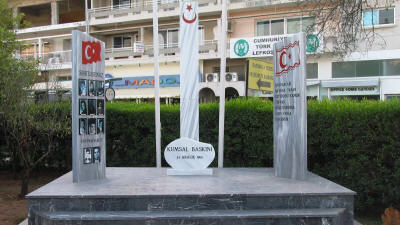Museum of Barbarism
Nicosia, North Cyprus
I thought long and hard before I included this museum in a list of "places of Interest". In the end, what prompted my decision was the fact that since 1974, the south of the Island has been giving the impression that up until then everything was peaceful, and that the "invasion" of Turkey prompted one-sided atrocities. Indeed there are many "museums" in the south doing precisely this.
 |
| Memorial at the Museum of Barbarism |
Most people seem to forget that for a number of years, there was effectively a civil war in Cyprus, not helped by a virtually unworkable constitution on independence in 1960. It comes as a surprise that the division of Nicosia into Greek and Turkish areas predates 1974 by many years. In the early 1960s there was effectively ethnic cleansing of the Turkish Cypriots who were "encouraged" to move into their own areas. Sporadic violence by one faction against another was rife, but came to a head over Christmas 1963.
On the 24th December, Greek Cypriot irregulars forcibly entered the house of Dr Ilhan, who was a Major in the Turkish army, and was on duty that night. The Doctor's wife, three children and a neighbour were killed by machine gun fire, and 6 neighbours were seriously injured. The house remains almost as it was found that Christmas.
This is by far the most disturbing museum on the island. The inside of the bathroom where the murders took place was left intact, with captions explaining that the spots on the walls are the actual blood of the four victims. In the other rooms are photographs of other victims of ethnic violence over the years.
The London Times reported on the 27th December 1963.
Nicosia, Dec 26.- Dr Kucuk today bitterly accused Greek Cypriots of what he called a series of "atrocities" against members of the island's Turkish Cypriot minority. He told reporters at least 300 Turkish Cypriots had lost their lives in the past few days, many of them women and children.
Dr Kucuk told the reporters, who reached the besieged Turkish quarter with the American Ambassador, Mr Fraser Wilkins, that there was a growing shortage of food, water and medical supplies. He complained bitterly about "violations of the ceasefire agreement by Greek Cypriots".
Be warned, the exhibits are graphic, and you will need a strong constitution to view them. Perhaps your time would be better spent in contemplation at the memorial erected in the garden of the house, and hope that the time will soon come when museums such as this (on both sides of the divide) can be closed, and I can delete this entry from the web site.
See location in Google maps.
Back to Nicosia Index.